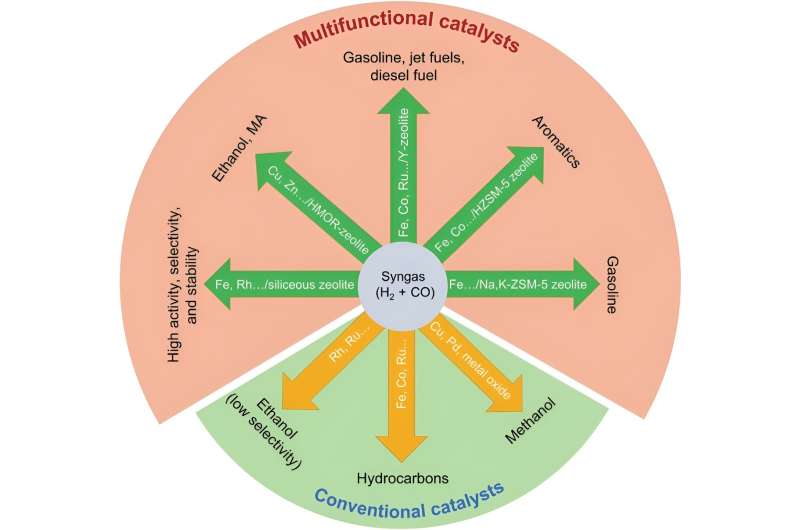Team examines importance of zeolite in catalysts for syngas conversion

The fuels used today depend heavily on petroleum. As the demand grows, scientists are looking for ways to produce fuels that do not require petroleum. A research team set out to examine the role of zeolites in the conversion of synthetic gas to fuels. Wanting to better understand how zeolites regulate the reaction pathways, they reviewed the most recent advancements in synthetic gas conversion with catalysts containing zeolites.
Their review paper is published in the journal .
As an alternative to fuels dependent on petroleum, for a long time scientists have looked to synthetic gas, or syngas, as a solution. Syngas is a mixture of carbon monoxide and hydrogen gasthat is easily obtained from coal, natural gas, and biomass. For about 100 years, scientists have studied the conversion of syngas into valuable fuels and chemicals.
The Fischer-Tropsch synthesis (FTS) is a successful route that scientists use for syngas conversion into hydrocarbons. This popular conversion method was invented by Franz Fischer and Hans Tropsch in the 1920s. In this process a series of chemical reactions produce hydrocarbons. Scientists use various models to determine the selectivity of this FTS process. The simplest and most widely used is the Anderson–Schulz–Flory (ASF) model.
Generally the products resulting from the conventional FTS method adhere to the Anderson-Schulz-Flory model and are limited. As an example, olefins, alkanes, and gasoline fraction have a limited value of content at only about 58% and 48%. Scientists need a way to optimize the product distributions from the FTS process. Yet this remains a challenge.
Scientists have found that zeolite effectively optimizes the reaction pathways beyond the conventional FTS method. Zeolites are hydrated aluminosilicate minerals. They are solids, but have a three-dimensional crystal structure that allows them to take in and lose liquid easily.
The zeolite works to regulate the reaction process. With zeolites, scientists have been able to improve the selectivity of gasoline, jet fuel, and diesel. These results are an improvement over the results seen with the Anderson-Schulz-Flory model. They have also achieved numerous aromatic products, using zeolite catalysts.
"In light of these results, we thought it was appropriate to review and discuss the recent advancements in the significance of zeolites in syngas conversion," said Liang Wang, a professor with the College of Chemical and Biological Engineering, Zhejiang University.
The research team reviewed the most recent advancements in FTS over catalysts containing zeolites. They also examined the role of zeolites and their structure-performance interplay. "Based on the catalytic mechanism, it is expected that the rational design of zeolites will be helpful for the development of more effective catalysts and reaction processes," said Wang.
From their study, the team determined that zeolite effectively optimizes the reaction pathways beyond the conventional FTS process. They believe that zeolite-assisted syngas conversion is still growing.
They make several recommendations for areas where future research might be focused. Up till now mostly aluminosilicate zeolites have been used, working with the FTS catalyst. The team recommends that more zeolite properties should be considered in future studies.
Scientists exploring the structure-activity relationship of catalytic materials at the atomic scale have benefited greatly from advances using in situ characterizations and theoretical simulation methods. The team recommends that future research in this area's focus on combining artificial intelligence and massive data.
Focusing in this way will allow researchers to design catalyst structure by better understanding the elementary steps. "This will provide the foundation and research direction for understanding the reaction mechanism, and finally designing the corresponding zeolites," said Wang.
More information: Hangjie Li et al, Importance of zeolite in multifunctional catalysts for syngas conversion, Carbon Future (2023).
Provided by Tsinghua University Press



















